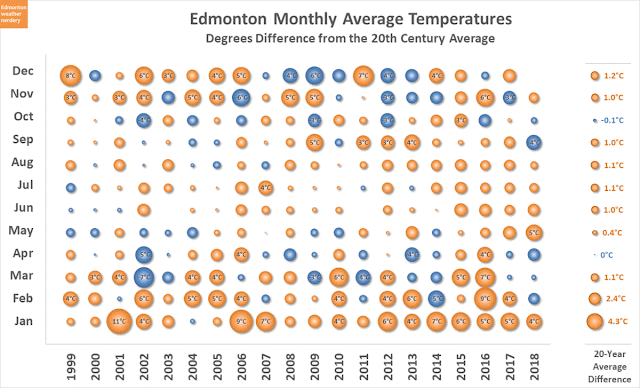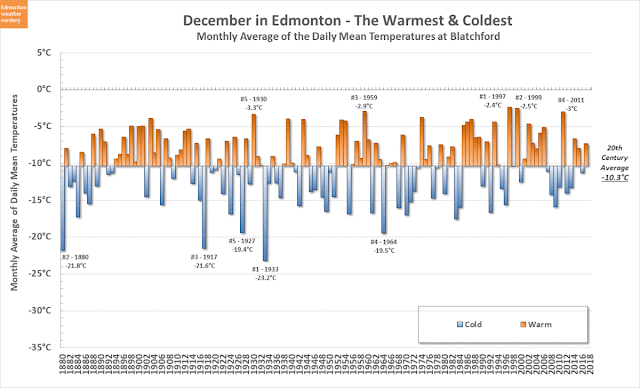High Temperatures
The start of the month was not very encouraging, with a week of Highs well below average. But after that cold start the temperatures warmed up, and the last 3 weeks of the month were 10°C to 15°C warmer than the first week was.
We didn't set any all-time records this month, but November 6th & 7th were the coldest since 1996 at -9.9°C and -5.7°C respectively. And then November 14th was the warmest since 1996 at 10.6°C.
The last week of November was pretty pleasant, and it had me wondering how often we have temperatures above freezing right at the end of November:
Looking at the orange boxes in this table we can see that a warm final week of November is actually pretty common - 2018, 2017, 2015, 2011, 2009, 2008, 2004, 2002 and 1999 all had days above 5°C.
In the writeup last month I had said that it wasn't unusual for November to have 20 days with Highs above freezing. At the start of this month that didn't look like it was a good bet to make, but by the end we'd hit 19 days above 0°C. That isn't a lot compared to 2009 which had 30 days and 2008 which had 28, but it's not bad.
On the cold side of things we didn't have any Highs below -20°C, or -15°C, or even -10°C. That isn't rare, but it's a bit uncommon with 2015, 2009, 2008, 2004 and 1999 as the only other recent years to do that.
The average High for November 2018 was 1.7°C, and that is right around the middle of recent years. In comparison though, November 1918 is on the far right side of the chart, and the average High a century ago was a balmy 3.9°C.
Low Temperatures
For the Low temperatures at the start of the month we were right at the bottom of the recent (since 1996) range, although that's still 10°C or 15°C warmer than the record Lows. And as we saw with the Highs, after that cold first week things warmed up, and mostly stayed well above average through the end of the month.
Warm & Cold Novembers
When we add up the Highs & Lows the average temperature this November was -2.2°C, which made it the 53 warmest November since 1880. In terms of Highs it was the 56th warmest, and for Lows it was the 43rd.
So this was an above average November, but it was not particularly unusual.
The dotted red lines in this chart show the 10-Year average Highs, Lows, and Means for November, and as we saw a few weeks ago in The Months through the Years Edmonton's temperatures during November haven't warmed up all that much over the years.
For 2018 so far then, November is the 6th month that was warmer than the 20th Century average, versus 5 months which were cooler. At the end of December we'll do the full 2018 temperature report card to see how it ranked overall - for now lets just say that 2018 has not been a particularly warm year overall.
Comparing November 2018 to other recent years it wasn't as warm as the very warm November 2016, and it was a little cooler than 2015, but it was warmer than every other November back to 2009. But Novembers in general just haven't seen the more extreme changes of January and February.
And this chart just gives Edmonton's recorded history of warm and cold months.
Precipitation
In November the International recorded 26mm of Precipitation (rain & snow). That's a bit more than the average of 20mm and last year's 20mm. Blatchford only recorded 15mm, although it also had a few days of missing measurements.
Rain
We don't necessarily think of November as a rainy month in Edmonton, but it's actually fairly common, especially in the first half of the month. This chart shows how often the International Airport has had November rain since 1995.
Totaling the November rain up for each year, in 2018 we had 6 days with rain and a total of 7.2mm. The average is about 2 days and 2mm, so this year was above average.
Snow
In terms of snow November 2018's 17cm was just a bit below the average of 20cm, and just a bit below last year's 19cm. And that was above the 8cm we got in October this year, but well below the ridiculous 38cm in September.
Typically November, January and March are our big snow months, all averaging around 20cm. December is a step below that, and then February and April are another step down.
For the winter so far our total snow is 64cm. That's well above average, thanks mostly to our ridiculous September.
Snowdepth
Here is the snowdepth at the International so far this year. Our early October snow hung around for quite awhile before finally melting off. And then we got another blast of it at the beginning of November.
The warm temperatures at the end of November seemed to melt a lot of snow inside the city, but at the International the snowdepth has held pretty constant at 7cm.
...and since that pesky snow hasn't melted, I think we will make the official call that the first "lasting" snow of the winter of 2018-2019 was on November 1st. That's one day later than last year's October 31st, but both of these last two winters were pretty early. The also both had very early first snows, way back in the 2nd and 3rd weeks of September.
December Temperatures

For the Lows, in the last 19 years there have been 2 December which didn't hit -20°C, and 11 which didn't hit -25°C. So that's something, I guess?
As a reminder of last December, it was incredibly warm right up until Christmas Eve, and then we were slammed with a deep freeze that lasted into the first week of January.




































